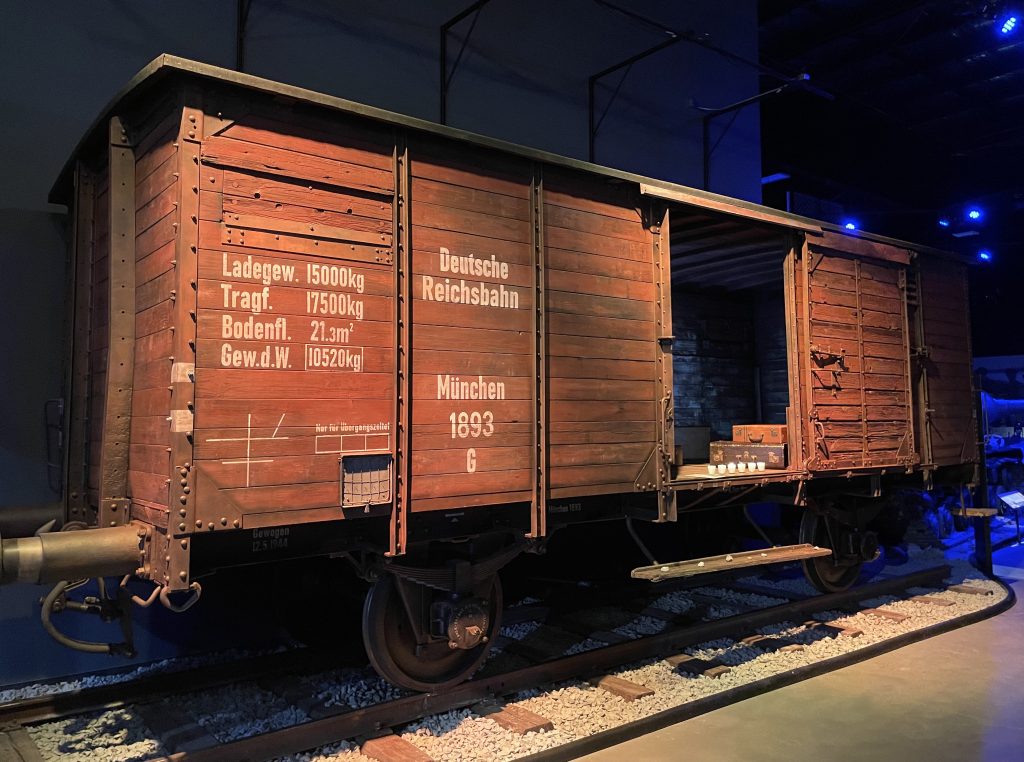Holocaust

1913 Deutsche Reichsbahn Rail Car – GERMANY
THE DESTRUCTION OF A PEOPLE
“Who has inflicted this upon us? Who has made us Jews different from all other people? Who has allowed us to suffer so terribly up till now?”
– Anne Frank
Anti-Semitism, sometimes called history’s oldest hatred, began in ancient Babylonia, Greece, and Rome. It continued through the Crusades where Jews had been persecuted, but this is nothing compared to the horrific Holocaust (Shoah) by the Nazi Regime in 1941 – 1945.
In Hitler’s “Mein Kampf” he wrote of a “Jewish Conspiracy” to take over the world. Elected Chancellor of Germany in January 1933, and as a member of the National Socialist German Workers’ Party (NSDAP) called Nazis, he would take over total control upon President Hindenburg’s death in 1934 on a platform of German nationalism, racial purity, and global expansion (Lebensraum or “living space”).
The first concentration camp, Dachau, in March 1933 would house political opponents such as Communists or Social Democrats. Under such control of Heinrich Himmler’s Schutzstaffel (SS), anti-Semitism increased with the Nuremberg Laws of 1935, leading to violence at Kristallnacht in November 1938 where 100 Jews were killed, and thousands were arrested.
In September 1939, tens of thousands of Polish Jews were forced from their homes into ghettos. In 1941, having conquered Denmark, Norway, the Netherlands, Belgium, Luxembourg and France, Jews and Gypsies were transported to Polish ghettos and then to concentration camps. All Jews were marked with a yellow star.
As Germany invaded Russia, mobile killing units, known as Einsatzgruppen, would murder 800,000 – 1.4 million Soviet Jews. At the 1942 Wannsee Conference in Berlin, Reinhard Heydrich would come up with Endlösung, the “Final Solution.” Extermination camps or killing centers would be established in six locations in Poland with the first mass gassing in March 1942 at Bełżec, followed by followed by Chelmno, Sobibór, Treblinka, and Majdanek. At the largest death camp, Auschwitz-Birkenau, an estimated 1.1 – 1.3 million were murdered, 2,000 at a time, 12,000 incinerated per day, of which 90% were Jews. Extermination camps genocide included 3.1 – 3.2 million people, of which 2.7 million were Jews.
The healthy were sent to a system of 42,000 concentration camps and sub-camps which played a pivotal role in economically sustaining the German reign of terror. A substantial percentage of the prisoners in Bergen-Belsen, Buchenwald, Dachau, Gross-Rosen, Mauthausen-Gusen, Ravensbrück (a women’s camp,) Sachsenhausen and others would die of starvation and disease.
Altogether, the Nazis murdered 6 million Jews, almost two-thirds of Europe’s Jewish population.
After the war, death camp commandants and high-level Nazi leaders, including Adolf Eichmann, would be captured, tried, and executed. Jewish survivors seeking a new homeland would lead to the creation of Israel in 1948.
The primary artifact in the American Heritage Museum’s Holocaust exhibit is the WWII German cattle car. This 1913 rail car was imported to the United States by the American Heritage Museum from Nuremberg, Germany in the summer of 2023 and has undergone a complete restoration. This 30-foot long, two-axle freight wagon is the type used by the Nazi regime for the inhumane transportation of millions of innocent Jewish people and other persecuted groups to concentration camps and extermination sites across Europe from 1933 to 1945. While no rail car can be directly traced to this terrible use as records were not kept of this type, the sheer numbers of victims transported during the Holocaust points to the likelihood that every car would have been used in this way at some point in its history.



